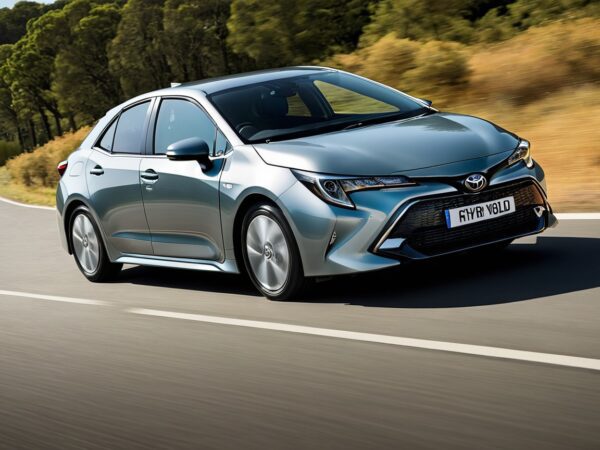Toyota RAV4 hybrid battery type

The Toyota RAV4 Hybrid uses two types of batteries depending on the model:
1. Toyota RAV4 Hybrid:
- Battery Type: Lithium-Ion (Li-Ion) or Nickel-Metal Hydride (NiMH) depending on the region and trim.
- Capacity: 1.6 kWh.
- Voltage: 259V.
- Cooling System: Air-cooled.
2. Toyota RAV4 Prime (Plug-in Hybrid):
- Battery Type: Lithium-Ion (Li-Ion).
- Capacity: 18.1 kWh.
- Voltage: 355V.
- Cooling System: Liquid-cooled for better performance and safety.
Toyota RAV4 Hybrid vs. RAV4 Prime: Battery Comparison
| Feature | Toyota RAV4 Hybrid | Toyota RAV4 Prime (Plug-in Hybrid) |
|---|---|---|
| Battery Type | Lithium-Ion (Li-Ion) or Nickel-Metal Hydride (NiMH) | Lithium-Ion (Li-Ion) |
| Capacity | 1.6 kWh | 18.1 kWh |
| Voltage | 259V | 355V |
| Battery Placement | Under rear seats (optimized for space) | Under floor (lower center of gravity) |
| Cooling System | Air-cooled (efficient but simpler) | Liquid-cooled (better heat management, more durable) |
| Charging Method | Regenerative braking, engine charging | Plug-in charging (Level 1/2) + regenerative braking |
| Electric-Only Range | None (standard hybrid, electric assist only) | 42 miles (68 km) on electric-only mode (EPA estimated) |
| Warranty | 8 years/100,000 miles (hybrid components) | 10 years/150,000 miles (battery warranty in some regions) |
| Maintenance Cost | Lower (no need for plug-in maintenance) | Higher (plug-in system requires regular checks) |
| Lifespan | 8-15 years (dependent on usage) | 8-12 years (higher stress on battery, faster degradation) |
| Replacement Cost | $2,000 – $4,000 (NiMH) or $4,000 – $6,000 (Li-Ion) | $6,000 – $8,000 (Li-Ion, due to larger capacity) |
| Performance Impact | Instant torque assist (hybrid mode only) | Pure EV mode + hybrid mode (dual functionality) |
| Environmental Impact | Lower energy use (hybrid mode) | Higher energy use but lower emissions (EV mode) |
✅ Key Differences:
- Energy Capacity: The RAV4 Prime’s battery is more than 11 times larger than the RAV4 Hybrid’s, providing an electric-only driving range.
- Cooling System: The Prime’s battery uses liquid cooling, which offers better thermal management, making it safer and more durable under heavy use.
- Versatility: The Prime can function as both an EV and a hybrid, while the RAV4 Hybrid is a standard hybrid without plug-in capability.
- Cost: The Prime is more expensive to maintain and repair due to the larger battery and plug-in system.
✅ Toyota RAV4 Hybrid vs. RAV4 Prime: Pros and Cons
| Aspect | Toyota RAV4 Hybrid | Toyota RAV4 Prime (Plug-in Hybrid) |
|---|---|---|
| Pros | – Lower upfront cost. – Simpler maintenance.- No need to plug in. | – Longer electric-only range (42 miles). – Higher performance (302 HP). |
| – Reliable hybrid technology (proven NiMH/Li-Ion). | – Eligible for EV incentives (tax credits).- Lower fuel costs (EV mode). | |
| – Lightweight due to smaller battery. | – Quieter in EV mode. | |
| – Lower battery replacement cost. | – Advanced safety features (higher trims). | |
| Cons | – No electric-only driving range. | – Higher purchase price. |
| – Limited to hybrid mode only. | – Heavier due to large battery. | |
| – Less powerful (219 HP). | – Battery replacement is costlier. | |
| – Slightly lower fuel economy compared to Prime. | – Requires charging infrastructure for full benefits. | |
| Ideal For | – Users who prioritize simplicity and affordability. | – Drivers seeking electric-only range with hybrid backup. |
| Usage Scenario | – Daily city commutes with efficient hybrid mode. | – Longer trips using EV mode for daily drives and hybrid for long journeys. |
🚦 Which One to Choose?
- Choose the RAV4 Hybrid if:
- You prefer a lower-cost, reliable SUV with no need to charge.
- You want lower maintenance and long-term reliability.
- Your driving habits don’t benefit much from an electric-only mode.
- Choose the RAV4 Prime if:
- You have access to charging at home or work.
- You want a mix of electric-only driving for short trips and hybrid for long journeys.
- You prioritize power, performance, and lower fuel costs.
Detailed 5-year cost comparison between the Toyota RAV4 Hybrid and the RAV4 Prime
Here’s a detailed 5-year cost comparison between the Toyota RAV4 Hybrid and the RAV4 Prime (Plug-in Hybrid), incorporating purchase price, fuel, maintenance, insurance, depreciation, and other ownership costs.
🔍 5-Year Total Cost of Ownership
| Category | RAV4 Hybrid | RAV4 Prime |
|---|---|---|
| Purchase Price (MSRP) | ~$31,725 | ~$43,690 |
| Depreciation | ~$18,526 | ~$23,559 |
| Fuel Costs | ~$6,116 | ~$4,378 |
| Maintenance & Repairs | ~$4,000 | ~$6,620 |
| Insurance | ~$5,000 | ~$7,019 |
| Financing & Fees | ~$5,000 | ~$9,945 |
| Total (5 Years) | ~$70,367 | ~$95,211 |
Note: These figures are estimates and actual costs may vary based on location, driving habits, and other factors.
💡 Key Insights
- Fuel Efficiency: The RAV4 Prime offers significant fuel savings, especially for drivers who can maximize electric-only driving.(artsautomotive.com)
- Maintenance Costs: The RAV4 Prime’s larger battery and complex systems can lead to higher maintenance and repair costs over time.
- Insurance: Due to its higher value and advanced components, the RAV4 Prime typically incurs higher insurance premiums.(CarEdge)
- Depreciation: While both models depreciate over time, the RAV4 Prime’s higher initial cost results in greater total depreciation.
⚖️ Which Should You Choose?
- Opt for the RAV4 Hybrid if:
- You prefer a lower upfront cost and simpler maintenance.
- You don’t have regular access to charging infrastructure.
- Your driving primarily involves longer trips where hybrid efficiency shines.
- Opt for the RAV4 Prime if:
- You have access to charging at home or work.
- Your daily commute is within the electric-only range (~42 miles).
- You value higher performance and the flexibility of electric driving.(WSJ)
For a more personalized assessment, consider using tools like Edmunds’ True Cost to Own calculator or consulting with a local Toyota dealership.(Edmunds)
Let me know if you need further assistance or have other questions!


